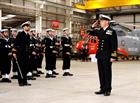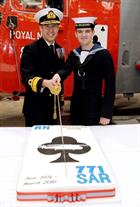End of an era – and an end of the 771 story as rescue squadron disbands
Nearly three months after its final search and rescue mission, 771 Naval Air Squadron has passed into history after formally decommissioning in Culdrose.
Nearly three months after its final search and rescue mission, 771 Naval Air Squadron has passed into history after formally decommissioning in Culdrose.
The head of the Fleet Air Arm Rear Admiral Keith Blount gave the order to haul down the White Ensign after assuring 771’s men and women that over 42 years they had made “a huge impact” on life – and lifesaving – in the South West.
To the strains of Auld Lang Syne, Lieutenant Commander Richard Calhaem salutes as the White Ensign is lowered for the last time and 771 Naval Air Squadron passes into history.
After 42 years of rescue operations from RNAS Culdrose – during which time 15,000 lives have been helped or saved during over 9,000 sorties – another chapter in the long, proud Sea King story closed.
The red-grey helicopters of the Ace of Clubs squadron stood down from search and rescue duties on New Year’s Day, when civilian firm Bristow assumed the mantle of flying lifesavers on behalf of the Maritime and Coastguard Agency.
It’s been something of a long goodbye for the squadron; they carried out a farewell flypast last spring, hosted a string of media in the autumn as interest in the end of military search and rescue increased, hosted a farewell dinner for rescuers past and present – and rescuees, including Duran Duran singer Simon Le Bon, saved from his capsized yacht in 1985 – dropped in on schools and appeared in a few documentaries.
The head of the Fleet Air Arm, Rear Admiral Keith Blount, told the air and ground crew mustered in the hangar that they and their squadron had made “a huge impact across the South West. The personnel and their famous ‘Ace of Clubs’ helicopters will never be forgotten. They have saved an innumerable amount of lives, and they will take the Squadron ethos, Non Noblus Solum – Not Unto us Alone – wherever they go.”
At the end of the ceremony, Lt Cdr Calhaem asked the Admiral for permission to ‘Decommission the Squadron’. He reluctantly agreed and the Navy’s standard was hauled down as the band of Her Majesty’s Royal Marines struck up.
“It’s a sad day, very sad day, but in the end, you have to move on in life,” said engineer AET Simon Cataldo, who’s spent nearly three years maintaining the Sea Kings – some of the airframes are 45 years old – ready for scrambles.
Lt Cdr Calhaem – who was on duty for the final 24 hours of SAR missions at the beginning of the year – added: “771’s been a fantastic squadron, around for a long time, responsible for saving a lot of people over the years. This is a sad day – very much the end of an era.”
Culdrose will continue to train crews in search and rescue as it is an essential skill for aviation at sea.






